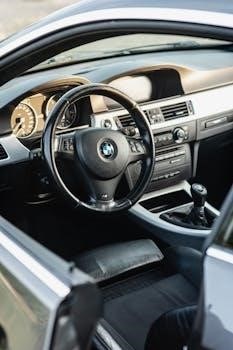Race car transmissions are a critical component, influencing performance significantly․ The debate between automatic and manual centers on control versus speed and efficiency․

The Question of Automatic vs․ Manual
The choice between automatic and manual transmissions in racing is a complex one, deeply rooted in the specific demands of the racing discipline․ Manual transmissions, once the standard, offer drivers a direct connection to the car and a nuanced control over gear selection, which is beneficial for precise cornering and power delivery․ However, they require significant skill and can be physically taxing․ Automatic transmissions, on the other hand, prioritize speed and ease of use․ Modern automatics, especially those found in drag racing, have evolved to shift faster than any human, resulting in reduced lap times and more consistent performance, which is often preferred for all-out acceleration․ The debate continues as technology advances, with each type possessing unique advantages․
Types of Racing Transmissions
Racing transmissions vary widely, including sequential manuals, dual-clutch systems, and automatics․ Each type offers distinct performance characteristics tailored to different racing styles․
Sequential Manual Transmissions
Sequential manual transmissions, often called sequential gearboxes, are a type of non-synchronous manual transmission favored in motorsports․ Unlike traditional H-pattern manuals, they shift gears in a linear sequence, either up or down, using a lever or paddle shifters․ This design allows for quicker and more precise gear changes, enhancing a race car’s acceleration and responsiveness․ The sequential nature eliminates the risk of mis-shifting, providing drivers greater control and confidence when navigating challenging tracks․ This form of transmission is now widely used in many race cars, offering a blend of driver engagement and performance advantages․ Its popularity stems from its efficiency and the speed at which gear changes are made, both crucial elements in competitive racing․
Dual-Clutch Transmissions (DCT)
Dual-clutch transmissions, or DCTs, represent a hybrid approach, combining elements of both manual and automatic systems․ They utilize two separate clutches, one for odd-numbered gears and one for even-numbered gears, allowing for incredibly rapid shifts with minimal power interruption․ This design provides the efficiency of an automatic transmission with the speed and control often associated with manual systems․ DCTs are especially effective in racing, where seamless and quick gear changes are crucial for maintaining momentum․ They allow drivers to keep both hands on the wheel while shifting․ Some racing cars use this hybrid approach to provide an optimal driving experience, delivering both speed and ease of operation․
Automatic Transmissions in Drag Racing
Automatic transmissions have found a strong foothold in drag racing, where maximizing acceleration is paramount․ Unlike road cars, these automatic transmissions are often heavily modified for racing․ They are designed for quick, consistent shifts, which are crucial in the short bursts of a drag race․ The use of planetary gear sets in some automatic transmissions allows for multiple gear teeth to be engaged at once, making them incredibly durable․ Historically, the GM Powerglide and the three-speed Turbo have been very popular․ The simplicity and robustness of automatic transmissions make them a favored choice for drag racing, where reliability and speed are critical; The technology in this area continues to advance․
Evolution of Racing Transmissions
Racing transmissions have evolved significantly, moving from traditional H-pattern manuals to faster, more efficient systems․ These advancements reflect the pursuit of optimal performance․
The Shift from H-Pattern to Sequential
The transition from the traditional H-pattern manual gearbox to sequential transmissions marked a significant leap in racing technology․ H-pattern gearboxes required drivers to move the gear lever through an ‘H’ shaped pattern, often leading to slower and less precise shifts․ Sequential gearboxes, however, allow for up and downshifts in a linear fashion, one gear at a time, significantly speeding up gear changes․ This evolution was driven by the need for faster, more consistent lap times and reduced driver workload․ The adoption of sequential systems revolutionized motorsport, beginning with the introduction of paddle shifters which further enhanced shift speed and driver control․ This shift was pivotal in enhancing on-track performance and reducing the potential for missed shifts․
Paddle Shifters and Electronic Control
The introduction of paddle shifters and electronic control systems further revolutionized race car transmissions․ Paddle shifters, mounted on the steering wheel, allowed drivers to change gears without removing their hands, maximizing control and reducing shift times․ Electronic control systems brought another layer of sophistication, managing clutch engagement and throttle blips during gear changes․ These systems dramatically improved shift speed, precision, and consistency․ Electronic control also enabled automated downshifts, protecting the engine and drivetrain from damage․ The combination of paddle shifters and electronic control has become standard in many racing disciplines, showcasing the move towards greater automation and efficiency in gear changes․ This technology allows for quicker lap times and a more engaging driving experience․
Specific Transmission Technologies
Various specialized transmission technologies exist in racing; These include Continuously Variable Transmissions (CVT) and robust dogbox transmissions, each suited for specific racing demands․

Continuously Variable Transmission (CVT)
Continuously Variable Transmissions (CVTs) offer a unique approach, differing from traditional stepped gears by providing a seamless range of ratios․ While CVTs are often associated with fuel efficiency in road cars, their application in racing is less common․ The appeal of a CVT lies in its capacity to maintain an engine’s optimal power band without interruptions from gear changes․ This could offer an advantage in certain racing scenarios by ensuring constant acceleration․ However, the technology faces challenges with durability and handling the high torque outputs common in motorsports, which limits its widespread adoption in high-performance racing․
Dogbox Transmissions
Dogbox transmissions represent a specialized manual gearbox variant favored in motorsports for their rapid gear changes and robust construction․ Unlike synchromesh systems, dogboxes use “dogs” or engagement teeth instead of synchronizers, enabling clutchless upshifts, typically achieved with a quick lift off the throttle; This design choice prioritizes speed and direct engagement, crucial in competitive racing․ However, dogbox transmissions are not without drawbacks․ They are known for being less forgiving, requiring precise driver input, and can be harsher on components, leading to greater wear and tear․ The trade-off between speed and durability makes them a niche choice in racing․

Considerations for Choosing a Transmission
Selecting a race car transmission involves assessing driver skill and the specific demands of each racing discipline․ This choice significantly affects overall performance and lap times․
Driver Preference and Experience
Driver preference and experience play a crucial role in selecting a race car’s transmission․ Some drivers prefer the direct control and engagement offered by manual transmissions, finding it enhances their connection with the car and allows for more precise gear changes․ Experienced drivers who have honed their skills with manual gearboxes might find the transition to an automatic or dual-clutch system challenging․ Conversely, less experienced drivers might find automatic or sequential transmissions easier to manage, allowing them to focus more on racing lines and other aspects of driving․ Ultimately, the best transmission for a driver is the one that allows them to perform at their peak, feel comfortable, and confident․

Type of Racing Discipline
The type of racing discipline significantly influences the choice of transmission․ For example, drag racing often favors automatic transmissions, especially those like the GM Powerglide, for their robustness and consistent, rapid gear changes․ Road racing, on the other hand, might utilize sequential manual transmissions or dual-clutch systems, offering quick shifts while maintaining driver engagement․ Rally racing, with its varied terrain, might opt for durable manual transmissions or sequential options that can withstand harsh conditions․ Each racing discipline has unique demands and the optimal transmission is selected based on these specific requirements, ensuring maximum performance and reliability for the type of racing․
Future Trends in Motorsport Transmissions
Future trends include hybrid powertrains and advanced technologies․ Dual-clutch systems and continuously variable transmissions (CVT) are also areas of development, aiming for improved performance and efficiency․
Hybrid Powertrains and Transmissions
The integration of hybrid powertrains in motorsport is driving significant changes in transmission technology․ These systems combine internal combustion engines (ICE) with electric motors, demanding sophisticated transmission solutions to manage the power delivery efficiently․ Hybrid systems often use dual-clutch transmissions or advanced automatic variants to handle the complex power flow․ The goal is to maximize performance while also meeting increasingly stringent efficiency regulations․ This means developing transmissions that can seamlessly switch between power sources․ This advanced approach is also pushing for innovations in electronic controls and energy recovery systems․ The future of racing is intertwined with these hybrid technologies, making it essential for teams to master them․
Advanced Transmission Technologies
The pursuit of optimal performance in racing has spurred the development of advanced transmission technologies․ These include sophisticated electronic control systems that allow for extremely rapid gear changes, often using paddle shifters, surpassing the speed and precision of traditional manual shifting․ Continuously Variable Transmissions (CVTs), while less common in top-tier racing, are also being explored for their potential in specific applications․ Furthermore, the integration of advanced materials and manufacturing processes contributes to lighter, stronger, and more efficient transmissions․ These technologies aim to minimize power loss and provide maximum control over the car’s performance․ These innovations are crucial for competitive edge in modern racing․
